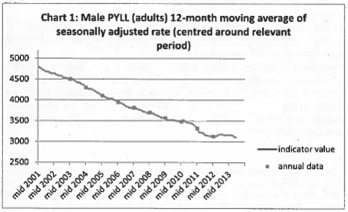National officials have identified a stalling of improvement in the prevention of premature deaths by the English health service, with one potential cause being the NHS’s “economic challenges”.
- Internal NHS England papers reveal improvement in key indicator is “plateauing” after years of reductions
- Possible reasons include constraint on NHS funding growth since 2010
- Could be beginning of a “general change in the trajectory of improvement”
An NHS England internal paper seen by HSJ says this prominent outcomes measure had “been improving steadily until 2010, but in 2012, 2013 and 2014 the improvement has been much more gradual”. It describes the effect as “plateauing”.
For males, the rate of potential years of life lost (PYLL) from causes amenable to healthcare deteriorated in 2013 for the first time since the first figures available, from 2001. For females the 2013 improvement was the smallest so far. Initial information for 2014 suggested little change, according to the paper.
The measure is a headline indicator in the NHS outcomes framework, which is meant to be used to judge success of the service. The government “mandate” to NHS England requires it to demonstrate progress against all outcomes framework indicators each year, and in 2013 the government said the NHS would prevent an “additional 30,000 premature deaths per year by 2020”, including by reducing deaths amenable to healthcare.
The NHS England paper says it is “possible that we could be about to see a general change in the trajectory of improvement that we have seen in the recent past”.
The organisation says the figures could “generate significant comment and speculation about the cause”.
The causes are not clear but the paper, and another on the same subject, both prepared by national NHS England officials in October last year, suggest three possibilities. The papers were released to HSJ last week in response to a freedom of information request in January.
One of the suggested causes is it “may reflect the recent economic challenges facing the NHS and a period of sustained flat real term investment in the NHS”. NHS spending growth has been close to zero in real terms since 2010-11, and between 2010 and 2013 there were falls in NHS spending per head of population. The rate of increase in the total was much higher during the 2000s.
A second is that large reductions in mortality from cardiovascular disease in recent decades, due to improved treatment and measures like the smoking ban, are coming to an end, meaning “we are now at a point where we will not see sustained improvements”.
The third possible cause given is a surge in mortality in 2012 and the first half of 2013, particularly April 2013, which has been linked to the severe 2012-13 winter. HSJ revealed concerns about this in 2013 and it remains the subject of investigation by Public Health England.
| Average reduction in PYLL per year | Males | Females |
| 2001 to 2009 | -3.6% | -3.5% |
| 2001 to 2010 | -3.5% | -3.5% |
| 2009 to 2010 | -2.4% | -3.7% |
| Mid 2011 to November 2013* | -2.7% | -2.2% |
| *Provisional data. Source: NHS England paper |
The papers, by NHS England director for reducing premature mortality Celia Ingham Clark and her team, consider what can be done in response. One says: “There are a range of well established and clinically proven interventions which could, if we were able to ensure a sustained focus on delivering them across the NHS, potentially serve to accelerate the rate of reduction in PYLL over the next five years and beyond.” It identifies a list of interventions NHS England has published previously. Other current work, such as the diabetes prevention programme, could also contribute.
HSJ understands NHS England has no updated analysis that changes the interpretation in the papers. The organisation has been approached for comment.




























1 Readers' comment